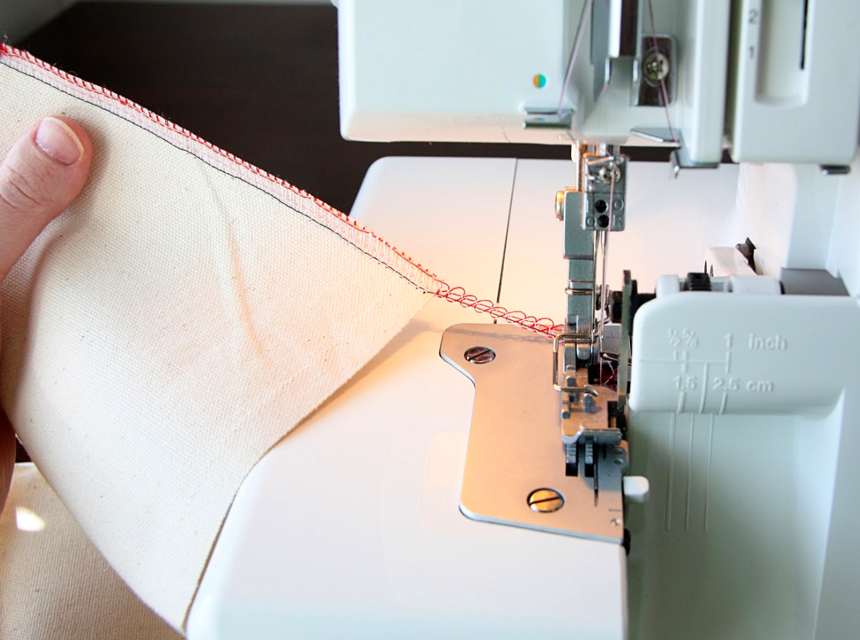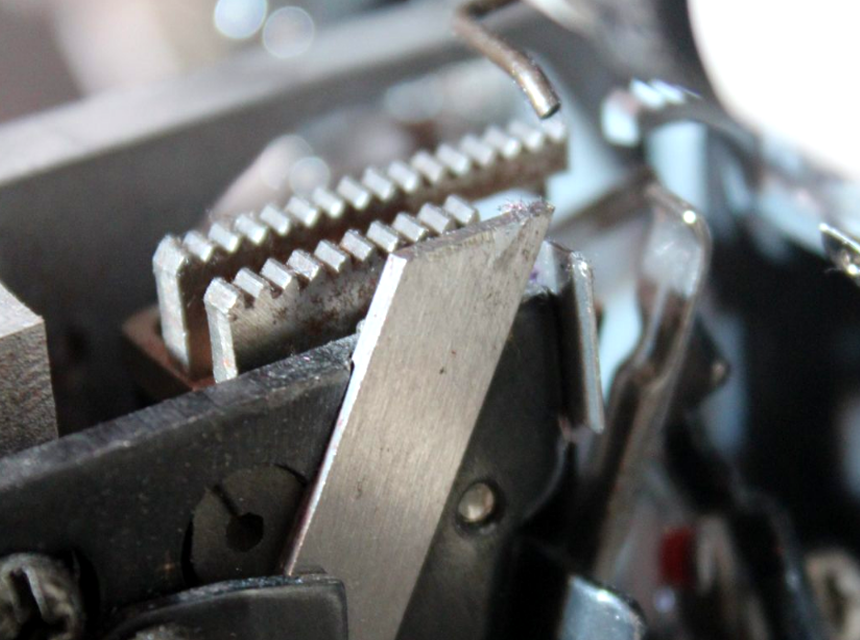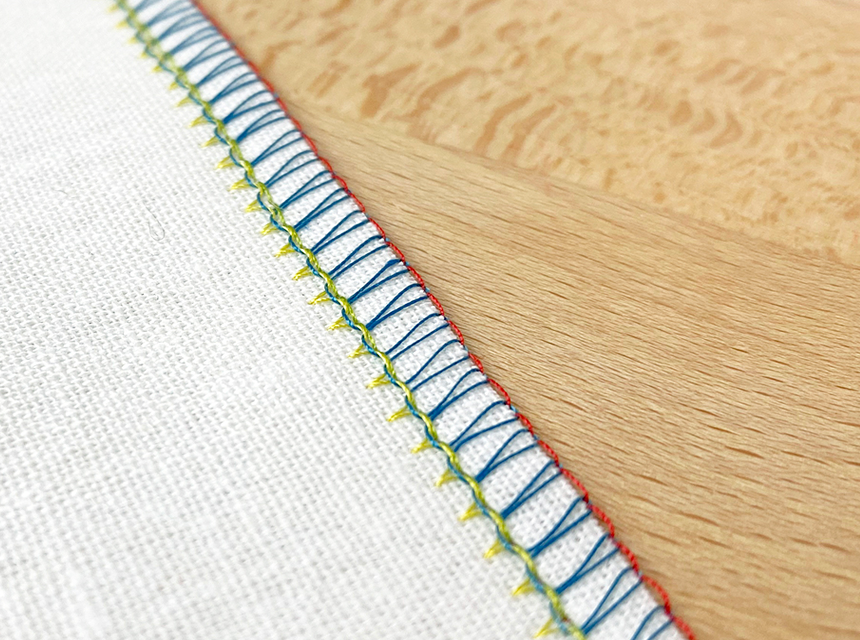
When you look into finishing machines, you’re likely to see one comparison: coverstitch vs. serger.
These machines are finishing machines and are made to sew seams and hems. However, they also have their own distinct uses, and it’s important to have the right one for the project you’re working on.
In the rest of this article, you’ll learn about the similarities and key differences between the coverstitch and the serger as well as when to use each one.
A coverstitch is a specialized sewing machine designed to hem and seam knit fabrics. It does this by using a chain stitch.
It is notoriously tricky to stitch knit or otherwise stretchy fabrics. Maintaining the tension becomes difficult, and the material moves around more than a stiffer fabric. Knit fabrics are also more difficult to hem because the raw edges of the fabric tend to roll up when left loose.
In addition to the relative difficulty of stitching the fabric, it’s also important that the hems and seams can stretch to avoid tearing. That’s where the coverstitch comes in.
By using what is known as a chain stitch, coverstitch sewing machines make hems and seams that are able to stretch with the fabric. That way, when you’re wearing your knit creations, they fit correctly and don’t have tight spots from the hems.
A serger is another type of sewing machine that is specialized for finishing fabric. That is, finishing seams and hemming the raw edges of the fabric.
The serger is a type of sewing machine that uses an overlock stitch to finish seams and hems. It also features a cutting knife that removes excess fabric from the seams as it sews.
A serger is a highly specialized type of sewing machine in that it only holds one function, finishing seams and hemming. They are also typically only able to complete one type of stitch, the overlock stitch.
To create this stitch, the serger machine uses anywhere from three to five threads at the same time. This is another feature that sets it apart not only from the coverstitch but also from other sewing machines. Coverstitches typically feature no more than three threads, while the average sewing machine only has one.
One unique feature that a serger has is a cutting knife. This sits alongside the needle and cuts off the excess fabric from the seams the machine is sewing them.
This is a handy feature for the sewer who has difficulty sewing seams, needs them to be especially durable, or simply wants to save time.

The average serger is capable of stitching thousands of stitches per minute, sometimes even up to 2,000, which is quite a bit more than even the fastest sewing machine. If your project requires you to hem a lot of fabrics, this could mean that you save hours of time by investing in a serger.
Sergers are also capable of creating especially durable seams. Since the overlock stitch is done with multiple threads, it is more durable than most stitches that would be programmed into a sewing machine.
The seams that they sew are also more consistent since the machine is doing the majority of the work. There is less room for human error with this device.
The most significant similarity between a coverstitch machine vs. a serger is that they are finishing machines and that both use multiple threads.
These machines are designed exclusively for finishing projects by either sewing seams together or hemming and finishing the edges of the fabric.
The coverstitch machine does this by using a chain stitch, a type of stitch that is specifically made to stretch. This makes sense, considering that coverstitch machines are intended for use on knit or otherwise stretchy fabrics.
Another similarity you’ll see when comparing coverstitch vs. sergers is that they both use multiple threads. This is different from the majority of sewing machines that only use one thread at a time. On average, a coverstitch machine uses three threads at once, while a serger machine uses anywhere from three to five, while this machine by Juki uses 6.
Keep in mind that the multiple threads can make both machines more difficult to thread.
After reading the previous section, you may be wondering what the difference is between a coverstitch machine and a serger. As a matter of fact, there are many key differences, as the differences between a coverstitch and a serger are more pronounced than their similarities.
Yes, they are both finishing machines, and they serve a similar function, but how they achieve that function is entirely different.
The differences between a coverstitch and a serger are that they use different stitches, are made for different fabrics, and a serger features a cutting knife. They even make combo machines, like this one from Babylock.
One of the most marked differences between the two machines is that they use different stitches.
The coverstitch machine uses a chain stitch. This is a stitch that is specifically designed to stretch along with the fabric. This makes it ideal to use on fabrics that need to stretch, such as the material for leggings.
If you take a look in your closet and look at any of your athletic wear, you’ll likely see chain stitching. Chain stitches are necessary in the case of athletic clothing because if the seams and hems didn’t stretch, you would run the risk of them ripping out of the clothing.
In contrast, a serger uses an overlock stitch Trusted Source Overlock Wikipedia Get to know all about an overlock and its history. en.wikipedia.org . This stitch is designed to be extremely secure and durable. It will not stretch near as much as the chain stitch. This makes it ideal for fabrics where you are worried about the potential of the seams separating over time or if you simply want some added security.
Sergers can typically be used for just about any fabric except knit fabrics Trusted Source Know Your Knit Fabrics Here are some basic facts about knit fabrics to help you develop your own cache of knowledge. This knowledge will soon find its way to your fingertips. www.threadsmagazine.com With knit fabrics, you don’t want to use a serger machine because its stitches are too rigid to stretch along with the material. That’s where the cover Stitch machine comes in.
Coverstitch machines are specifically designed to work with knit Fabrics. Knit fabrics are especially stretchy, which can make them more difficult to seam and hem. That’s because the seams and hems must stretch along with the fabric, or you run the risk of the fabric ripping when tension is applied.
If you were to try to use a coverstitch machine on a regular fabric, then the seam would not be secure enough to hold the fabric together. That is why it is important to understand what type of fabric you’re using that way, you can make the correct decision on what machine to use for that project.

The last difference between the two machines is the cutting knife. Sergers are unique amongst other sewing machines because they include cutting knives. This cutting knife goes alongside the needle, and as it is stitching the seams and hems, it cuts off the excess fabric.
This can save the sower a considerable amount of time as they won’t need to go in afterward to cut off the excess fabric from the seams. It will also allow for a neater, more professional-looking seam, as you won’t have the same variance in the amount of fabric that is being cut off.
Since the coverstitch machine does not feature this, the sewer will need to go in after the scene has been cut to ensure that excess fabric is not sticking out of the same. If there is a lot of hemming that needs to be done, this could mean hours of extra work for the sewer.
When you research coverstitch machines and sergers, you’re likely to also come across a machine known as the overlock.
This machine is very similar to both a coverstitch and a serger however; there are some key differences.
Although all three machines are similar overall, the surgery is more similar to the overlock than the coverstitch. So similar in fact, that many people think that they are the same machine or at least serve virtually the same function.
Both the sergers and the overlock use the overlock stitch to secure their hems. They are also both primarily ‘independent machines,’ meaning that the sewer doesn’t need to do a lot of work when using them.
As long as the machine is appropriately set up, all you should have to do is start the fabric and watch it work.
The main difference between the three machines is the number of threads they can use simultaneously, as well as the lack of a cutting knife in the case of the overlock and coverstitch.

On average, both coverstitch and overlock sewing machines use three threads at the same time. In contrast, serger machines will use anywhere from three to five. This means that their stitches are more durable because they have more threads supporting the seams and hems.
When comparing the sergers vs. overlock vs. coverstitch, one of the biggest differences you’ll notice is that of the cutting knife.
Neither the coverstitch nor the overlock typically features a cutting knife, while sergers almost always do.
The serger can greatly reduce the work of the sewer by trimming away excess fabric while sewing the seams and hems.
When someone first gets into sewing, they may be initially confused by the differences between a serger and a sewing machine. After all, they both look pretty similar to the untrained eye.
However, the two have some key differences, and both serve very different functions.
A serger is made specifically to stitch hems and seams using the overlock stitch. In contrast, a sewing machine is made to fulfill a variety of functions and is usually programmed with dozens of stitches.
Sergers are a type of sewing machine that is made just for finishing fabrics. They use anywhere from three to five threads and only make one stitch, the overlock stitch. This stitch is used to sew seams as well as finish the raw edges of fabrics. The machine also features a cutting knife to remove excess fabric.
Coverstitch vs. serger: how do they compare? Both are made to sew hems and seams, but they are individual products with some key differences that have their place in every sewer’s lineup.
Coverstitch machines are made to work on stretchy fabrics and do so by using a chain stitch. This stitch is made to move with the fabric, so no tears occur during movement.
In contrast, a serger is used for most other types of fabrics, creates a more durable seam, and also features a cutting knife to remove excess fabric from the seams and hems.